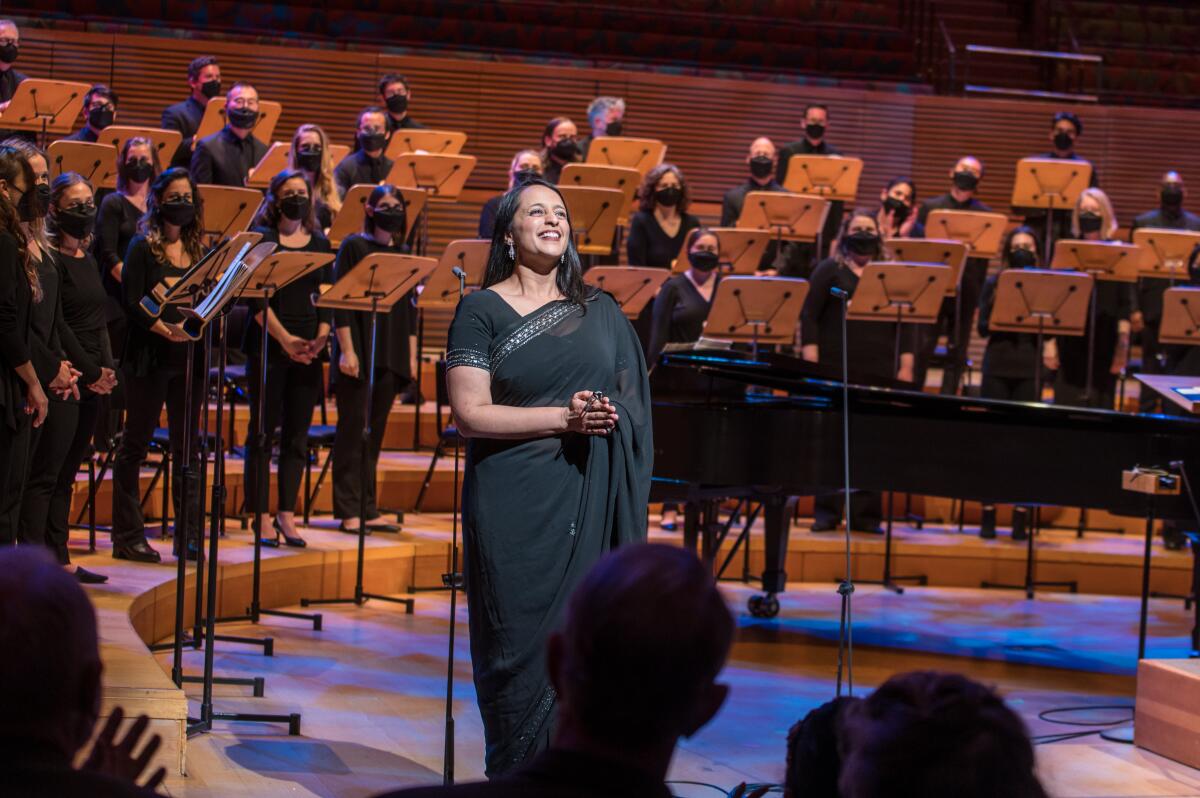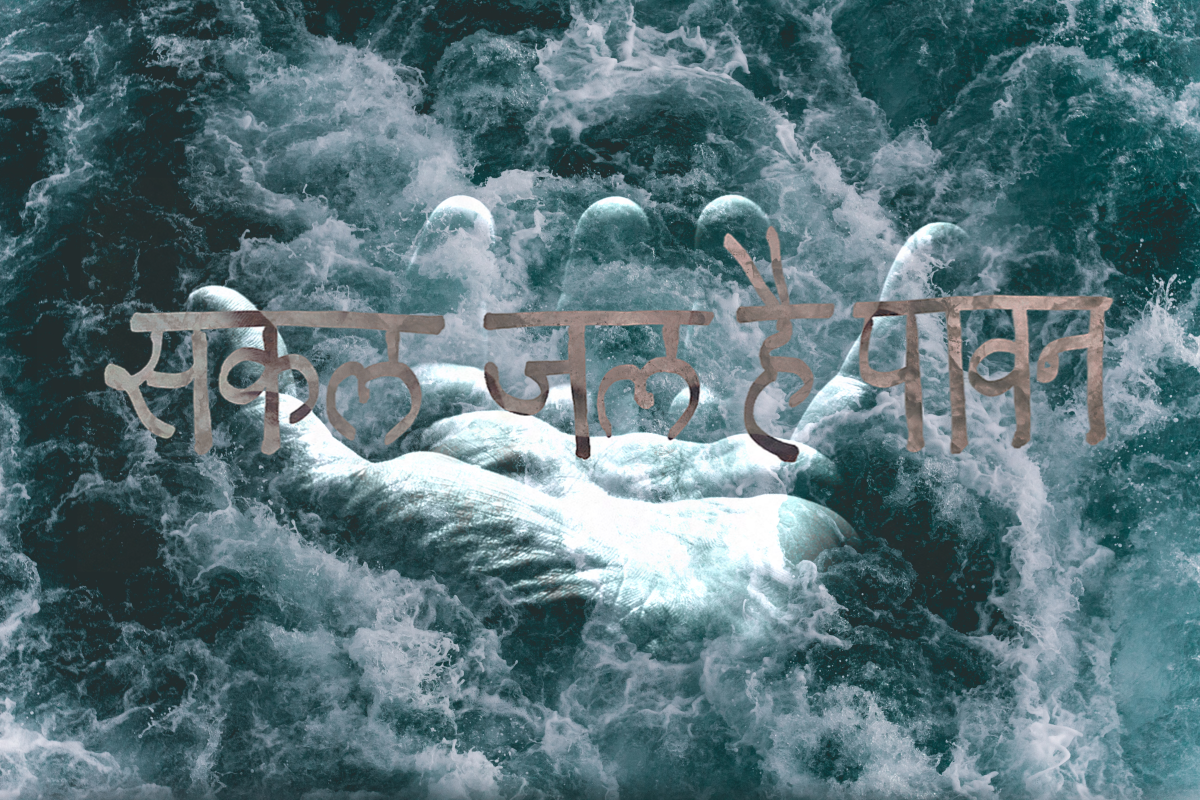California’s escalating water crisis galvanized composer Reena Esmail’s new work

Reena Esmail acknowledged the irony that we were talking about her new choral work — “A Requiem for Water,” inspired by California’s water crisis — in the midst of a deluge. She was wearing galoshes, as were many members of the Los Angeles Master Chorale, at an evening rehearsal earlier this week in a Glendale church, where dozens of dripping umbrellas were propped against the walls.
But, she pointed out with a laugh, the official title of her piece is “Malhaar,” which is the name for a subset of ragas — a form of Indian classical music — “that are supposed to beckon rain. So in the Hindu tradition,” Esmail said, “the lore goes that when you sing malhaar, rain comes.”
For the record:
11:30 a.m. March 26, 2023In an earlier version of this article, Reena Esmail is quoted as saying that “Malhaar” is part of Sunni tradition. “Malhaar” is a Hindu tradition. The article also says her father is from Punjab. He is from Gujarat.
An Angeleno who studied Western classical music at both Juilliard and Yale, the composer is also the daughter of Indian immigrants, and for the last decade, she has been conjuring a musical river that draws from two disparate cultures.
Her work is a duet between traditions, where classically notated orchestral and chamber ensembles dance with improvised, microtonal Hindustani vocals, sitars and violins. In her 2016 oratorio, “This Love Between Us,” Esmail realized that the tabla (Indian hand drum) player was having trouble following the Western conductor — so she paired him with a timpanist in the orchestra.
These two percussionists “developed this really close, beautiful bond with each other,” Esmail said. “And I thought: Wow, this is amazing, because they have to depend on each other. I’ve created this piece where the dependence is really necessary for both of them to know where they are in the structure.”
As a child growing up in Studio City in the 1980s and 1990s, composer Reena Esmail invented her own religion.
In 2020, the Master Chorale made Esmail their artist-in-residence, and for her first commission, she was inspired by that previous experience to try pairing a Hindustani vocalist — Saili Oak — with these L.A. singers, whom she made an effort to get to know throughout the pandemic.
Esmail took the residency that July, in the early mess of COVID-19, and “I knew when I took this commission that, by 2023, we would need to mourn something. I felt like a requiem needed to happen.”
The result is “Malhaar,” which will premiere Sunday on a program with Fauré’s Requiem in D minor at Walt Disney Concert Hall — come rain or shine. Esmail’s piece will be accompanied by striking projection designs by Camilla Tassi, splashed on the interior of the hall.

The work calls on many of the tributaries from Esmail’s life and creative journey. Her mother is Catholic and from Goa, and her father is a Muslim from Gujarat; the Latin Mass is as meaningful to Esmail as her more recent studies of Hindustani singing with Oak, a vocal teacher originally from Mumbai.
Esmail and Oak are both interested in the confluence between Indian classical and Western classical music, and Esmail started toying around with the Hindustani vocal tradition of alap — which is “so beautiful, and it’s so complex,” said Esmail.
“I thought to myself: Wouldn’t it be amazing if there were two words — one in Hindi and one in another language — and they were connected by their vowels?” she said. “So we came up with this idea of doing an ‘Agnus Dei,’ and that she would start with the Hindi term ‘He kartar,’ and on that ‘ah,’ it would become ‘Agnus Dei’ in the choir.”
“Malhaar” is patterned after the Requiem Mass, and includes a “Kyrie eleison” and “Requiem aeternam” — although Esmail intentionally picked the parts out of the traditional mass “that I feel are a little bit more universal and not necessarily specifically Christian. There’s a message there that appeals to everyone. I mean, everyone loses someone and needs to find a way to honor that.”
The piece is greatly inspired by the poetry of William O’Daly, who hails from the San Fernando Valley and is also the lead writer for the California Water Plan. The fourth movement is set to an O’Daly poem that asks: “Is this ever-descending water human tears? Do they mean nothing? ... Without you, how will we weep when we need to?” — which dovetails right into the ancient words of the “Lacrimosa”: “Full of tears shall be that day.”
With rhythmic support from a tabla, Oak’s Hindustani song glides in and around the California chorale as it flows and surges in English and Latin. The piece culminates in a dream about a waterfall, with all of these seemingly disparate influences cascading into hope-filled unity.
“In a way,” Esmail said, “I almost feel like I’m finding musical cognates. Sometimes those cognates mean one thing in a certain culture and they mean another thing in another culture or language. And you can use those cognates to create this glue that allows people to understand each other, maybe without even realizing that they’re understanding each other.”
'Esmail / Fauré'
Where: Walt Disney Concert Hall, 111 S. Grand Ave., Los Angeles
When: 7 p.m. Sunday, March 26
Tickets: $45-$153
Info: lamasterchorale.org
More to Read
The biggest entertainment stories
Get our big stories about Hollywood, film, television, music, arts, culture and more right in your inbox as soon as they publish.
You may occasionally receive promotional content from the Los Angeles Times.










